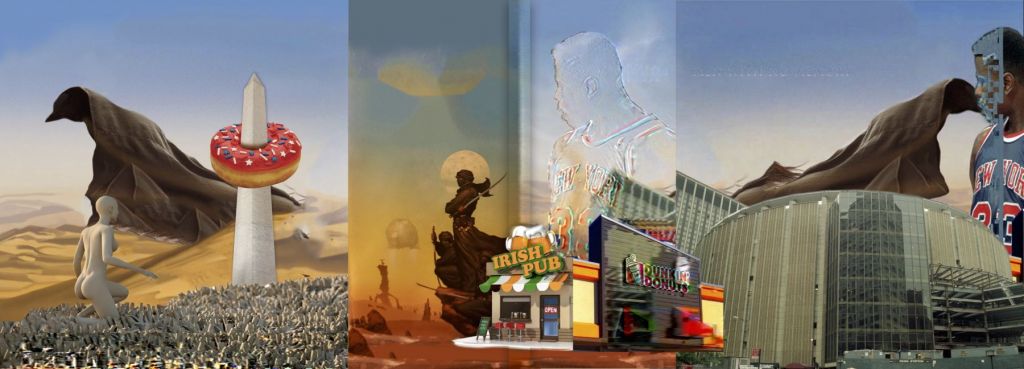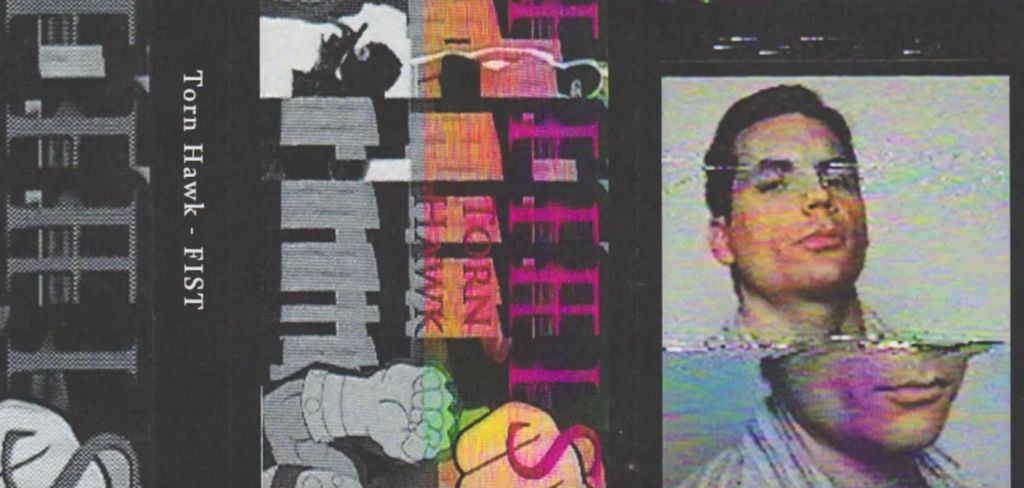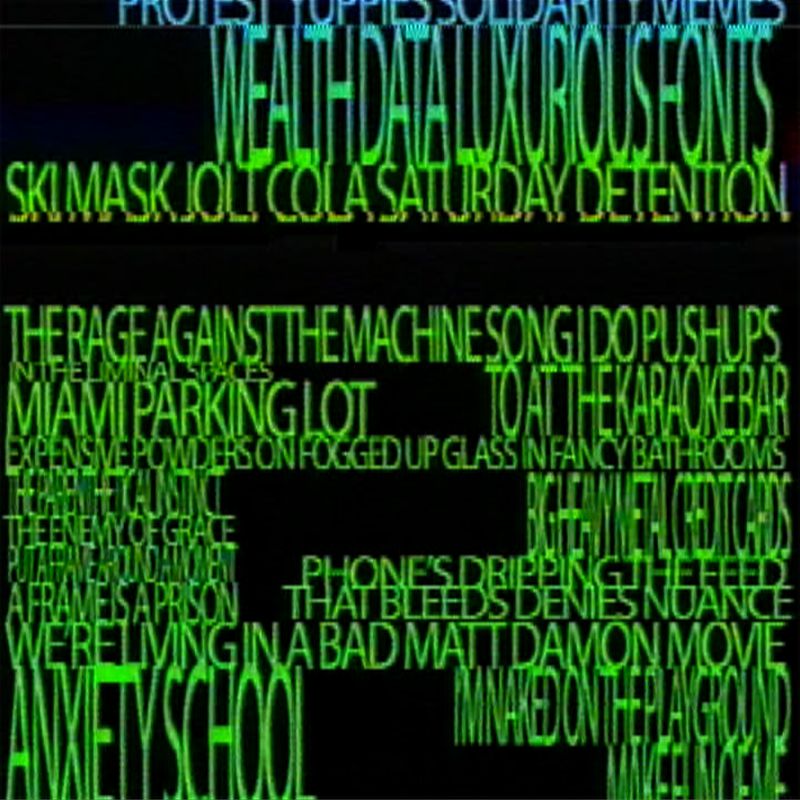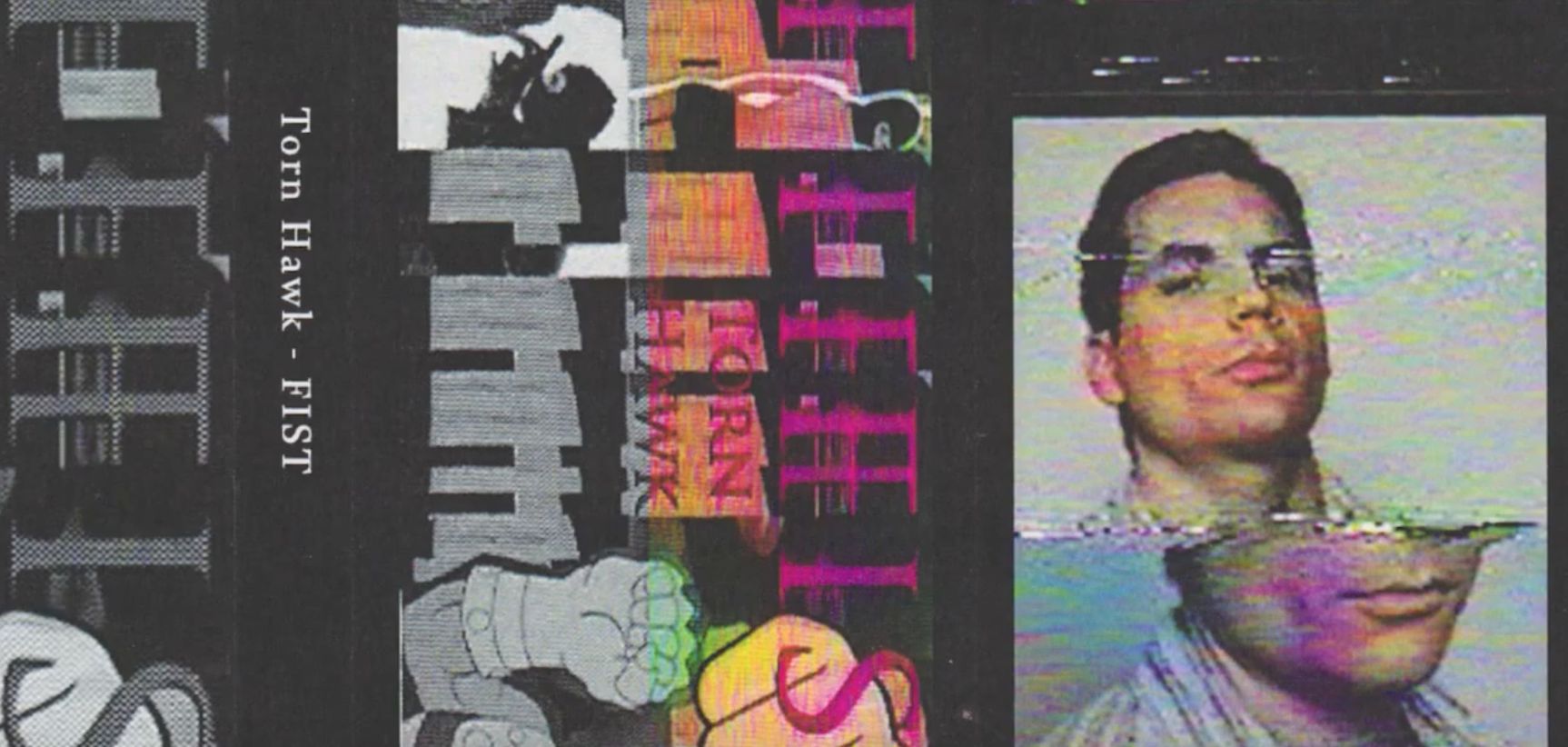Interview by Allan Gardner

Torn Hawk is a musical project from NYC-based artist and musician Luke Wyatt. Over more than twenty releases, the output has been characterized by an aesthetic of distressed sound. The palette illustrates familiar patterns, tones or instruments with a heavily degraded effect – maintaining an allegiance to the sonic makeup of contemporary pop music alongside a shifting compositional awareness, moving between genres track by track. It’s hard to define Torn Hawk. My first awareness of the project was Time Is A Scam (L.I.E.S, 2018), a release that sat firmly within Wyatt’s exploration of degraded audio, collaged into slabs of experimental pop.
Where the project gets most interesting for me is in its relationship to play-acting or world-building. Wyatt’s cosplay as a motivational speaker situated within a fractured world is as confusing as it is compelling. It feels like Adult Swim shorts, but if you said that, everyone in the room would sneer at you for making a normie reference. In earlier interviews, Wyatt described the visual and sonic aspects of his output as not being necessarily connected – influenced by one another, having a relationship no doubt – but existing in a fourth dimension.
The idea is that they can be encountered individually, within the context of his other works, or by interacting with selected pieces. If you see the motivational posters, with Wyatt wearing a Britney mic and a suit, they can be real. If that’s all you ever see, that’s how they manifest in your universe. If you see them in the context of his website – overlaid in collages with digital broken glass, bleeding and stuck with shuriken – maybe it’s different.
Wyatt’s new record is called Here Comes Language and came out recently on his own label Valcrond Video at the end of last year. It’s some of the most hi-def output I’ve heard from the Torn Hawk project and seems to have leaned further into the influence of bubblegum pop felt across a lot of electronic music in the last decade. For me, the record has a heavy Italo Disco flavour and, in some places, sounds kind of as if Xiu Xiu wasn’t trying to be weird on purpose. I don’t know who that’s more of a dis to – but it’s not supposed to be one to either of them.
Although existing in a pop format, this is atmospheric music. It feels like the songs were crafted with the intention of creating a little world and putting the listener in it. Like how when you listen to Running Up That Hill, it could make you feel like changing your life forever or like dancing pilled up in front of a smoke machine. In fact, in places, this record does kind of sound like Kate Bush playing in a post-apocalyptic 80s bar run by a guy who seems normal at first but turns out to be nuts.
When I was writing this, I decided to listen to Kate Bush just to make sure I wasn’t doing that thing where people mistakenly relate two things and create an internet vacuum in which they’re permanently entwined. Opening the video on YouTube, I was confronted with the most annoying man imaginable trying to explain to me why I had to get everyone in my family to download an app called Honey.
What struck me there was how different a relationship this record has to pop culture compared with the asinine entrepreneurial mentality Wyatt is making fun of. This music is truly weird in a way that feels like it’s trying to introduce the listener to all the alleyways of ephemera Wyatt exists in. I think there’s a lot of beauty in someone sharing that with you – even more when they let you in on the joke.
I appreciate that this intro might feel a little disjointed, with references poking out and allusions made to information that feels esoteric or inaccessible – but that’s kind of the Torn Hawk experience. It’s especially what this new record is. Here Comes Language is a grower, a profoundly weird listen that rewards you for the time you put in.



What would you say is the key element that stands out when people come across your music or video art?
I would hope they pass out and wake up with no injuries but instead the reverse of injuries, like magical enhancements or additions, wild appendages that are beautiful and useful, or bank accounts that are empty while their hearts are full as they shoot the cash they withdrew out of reconfigured t-shirt cannons.
Maybe they go write a big check to the gym teacher they despised, now an old man, lonely, not any smarter or more spiritually limber, still a human. And every human has a lot of interesting things to say and is worthy of love.
You are about to publish your sixth album as Torn Hawk, Here Comes Language. How do you see your sound has evolved over these years?
The first Torn Hawk recordings that people heard were actually a departure from the music I’d been making just before. Before Torn Hawk, I made very “clean” sounding music. I started Torn Hawk as a place for very distressed beat-up sounds.
That’s where the name came from— a noble, elevated being (a hawk) that is “torn” or broken. Who gives a shit about the name now? Names acquire their own resonance over time and depart from their origins, thank god, because the origins are often silly and get outgrown.
Anyway, the music I was making right before Torn Hawk was really hi-def glossy stuff, but nobody really heard that music or cared, so when Torn Hawk got attention, people assumed all my stuff had always had this degraded sound. Over 20 or so TH releases, I started to get tired of the distressed sound, or at least of music that only embodied distressed sounds without anything in opposition.
I’m now back to wanting to make hi-def shit. Within the glossy sounds, I place little bundles of trashy broken sounds that evoke OG Torn Hawk stuff. That is something I am interested in now— having levels of fidelity and resolution nested within each other: polished glass beads in a rotten straw basket or mustard-stained sweatpants folded inside a platinum shoebox.
In terms of a conceptual approach, I’m now more interested in bringing people into a discipline or a religion or a living system, an advice matrix. That was one of the main reasons I wanted to start using my voice in music, so I’d be able to hide secret messages in the vocal web of the recordings to help program people to reach their highest potential. I am also starting a structured coaching program for people who are interested in an overt, non-subliminal approach.
“Secret messages” sounds like something a kid would say. I am using that kind of language because I am trying to address needs that are quite low on the pyramid, and all those needs were articulated at a very young age.
I read that you are not very keen on big flashy concepts behind albums, but what was the creative process like for this last one? Has it been similar to your usual process?
I can use a concept to get started on an album, but I always want to be free to depart from a concept and follow my ears and heart if I have an idea that falls outside the concept. My overriding criteria is to make the best-sounding music I can make, so if a concept gets in the way of that, I throw it out. Concept records often suffer from people not understanding this.
I began this album just trying to truly integrate words or vocals into each composition, which is something I’d never been able to do. Once I had satisfied that goal tier, I worked on braiding in the “coded” messages.
This was accomplished not just through verbal means but also tonally, by using certain notes in particular sequences (scale-based auditory programming has a long history, easily researched online) and through the repetition of certain mathematical patterns expressed rhythmically. I was working off documented instances of human beings who were successfully programmed to modify their behaviour after listening to “hidden” verbal phrases, combined with rhythmic patterns or the repetition of numerical sequences.
In short, I was trying not just to write catchy, memorable songs with inventive lyrics but create “cognitive adjustment machines” to change people’s lives. Many people won’t be aware of the second function of the music, but anyone who listens will see improvements in their life.
Are you preparing a visual side for Here comes language? Considering the possibility of live shows has been considerably (if not completely) hampered? Or maybe you’ve thought of other platforms/formats for the visual content (something you’ve done in the past with websites and books)
I am making a video for one of the songs. I actually had to drag myself into making this video because I acknowledged that I need to do that at a minimum to bring more attention to the album. But for this album, I’d rather not have any visual component because the imagery I saw in my head when I arrived at the sounds and words was so strong.
And the images that will come to the listener through the coded messages and sacred/manipulative mathematics inherent in the rhythms should be left really vivid and untampered with by outside imagery. I’d rather not mess with that and nail down the imagery so people see ‘this sound = this image”.
It’s like the disappointment and disgust I felt when I saw the Lord Of The Rings movies. I had such strong imagery in my head when I read those books as a kid, and I really didn’t agree with the choices the filmmakers made. They wiped away some of my personal imagery forever. I wish I’d never tried to watch those movies.
Somebody else would have done a much better job, but really nobody could have lived up to what I saw in my head. And I think that is true for a lot of books and music, for many readers and listeners. Everybody has their own imagery, and that is a special personal world conjured by the music or book or whatever. Did My Bloody Valentine do videos for “Loveless”? I don’t even want to know. I’m sure they did, but a video for that kind of infinite music is so reductive.
Your early video work was influenced by VHS tape and glitched images. What interests you visually these days?
I’m always interested in the same things visually — compositions that zing with balance and intention. It might be a thousand-year-old painting, or it might be digital animation, or it might be the way somebody put duct tape over their broken car window.
This past year I created a video series with my friend Ari Russo for Boiler Room’s 4:3 platform. The series is called Skin Dive. Ari is maybe the only person I respect and trust in the area of sophisticated, delicate visual resonance and irony, but we still fought a lot during the process.
This was a good lesson in collaboration; I’m sure we’ll do better next time. But I also learned a lot in subtle ways just by having to clear ideas with him, and I notice these gains while working on the current video.
Some of your video work, especially when experienced live, can make you feel like being in a parallel melodramatic reality; what’s your take on new immersive technological developments in extended realities (augmented or virtual)?
I don’t know enough about most of that stuff to really comment. For video, I’m still making things with basically the same tools and programs I was 10 years ago.
I plan on updating my visual toolset in the next few years, but I just want to squeeze every bit of usefulness out of my original set-up before I move on. That’s how I treat all programs or pieces of equipment; if I am constantly updating and acquiring, I am always just working with the surface functionality of tools instead of twisting them to do things beyond what they might have been designed for.
There is one immersive technology I’m really interested in. My friend is working on it; it’s a secret, don’t tell anybody about it. Well, actually, it’s been around for a while, but not many people talk about it openly.
It involves a watermelon which has been hollowed out. You put your head inside the watermelon. It’s best to do this on a hot, humid summer day. If it is hot out, the cool insides of the melon seem more inviting. It’s easier to convince yourself to stick your head inside. You can anticipate the cold, wet flesh of the fruit inside rubbing against your face and scalp, and it will seem like a good idea.
The heat of your body and the heat of the air also helps to activate the pink sugary juices of the watermelon. Once your hot head is inside the melon for a while, the juices start to run down your neck and chest and get you all sticky. Ants hear about what’s going on and come by and crawl all over you— that’s an important part of the technology.
The melon, even while hollowed out, is so heavy and water-logged that you will soon need to lie down. And once you are down, there’s no way you are picking your head up. I recommend lying down face first. Whichever way you go down, face first or on your back, you are going to stay that way, so think hard before you choose a position.
If you are a “man” and you are going down face first, let me ask you a personal question: Do you keep your wallet in your back pocket? You can tell me. I keep my wallet back there myself. See, I went and told everybody that, and now next time I’m on the subway, somebody’s going to stick their hand in there and take all the non-money I keep back there.
Anyway, if you do have the wallet back there, put it in your front pocket or make sure to give it to someone you trust because once you are stuck on the ground, people might put their hands in your pockets and take things.
People without back-pocket wallets don’t have to worry about this; I’m sorry you had to read that part and imagine such basic levels of the implicit social pact being violated like this. They don’t have this problem in Japan. So if you are really worried about it only put a watermelon on your head in Japan.
Let’s get back to picturing something more positive. I’m talking about a 100-degree August day in Flushing Meadows, right near where the Mets play. Maybe you went to a game. Your seat in the stadium got sun all day, your head feels like stuff is cooking inside, the Mets lost, and there were some real jerks sitting near you who wouldn’t fan you with the big foam finger they got for free even when you tried to give them 5 bucks.
The game is over; you are out in the hot parking lot now; the hot blacktop is romantic in its blank potential and evocation of all the wonderful parking lots of your youth— a parking lot was always a canvas for mischief, glory, or transporting melancholy.
As a kid, you adored walking through empty parking lots in the hot sun; sometimes, you would just lie down on the black mottled melty surface and stare into the blue sky the overdrive sun was turning white and make lists of the cassettes you were going to buy when you rolled up enough errant quarters.
Right now, though, the romance of the parking lot had lost some of its steam, or it was gaining steam, the unwelcome pig-steam of Queens County carnivores off-gassing hot dogs, chilli and cheese as they waddled to their cars. Jesus, your head was going to explode if only you could stick it in something cool, wet, and dark.
Right then, a guy hands you a hollowed-out watermelon, the hole the perfect size for your sunburnt dome. You are going to stick your head inside, right? It’s not even a decision; it’s an instinct.
This is how people used to cool down in some parts of the USA back in the day. It is nothing to feel weird about. If you are a tradition-bound rule-following square, not a “rebel” or an “iconoclast”, you can rest assured that squares of the highest repute (I could name names) had their heads inside a watermelon from Day 1, 1776.
Let’s take the contemporary square scene, government bureaucrats, administrators, or (the better-paid but still square) lobbyists. How do you think all this serpentine regulation gets written? All the pleated khaki-wearing schlubs you see riding the Metro in the DC area, these people have their heads in watermelons all day long; they compose pages of complex regulation in their head while inside and just come out for quick spurts of dictation.
Maybe you’re not a square? Are you an artsy type? If you are truly an artsy type, the word artsy has made you stop reading this; maybe you just got sick to your stomach or felt a little bit more alone in the universe when you heard that word. I apologize. Let’s start over.
So you like “art”? The nice thing about having a watermelon on your head is that you often end up participating in visual artwork. What the hell am I talking about? While you are immobilised, people might encase other parts of your body in other kinds of hollowed-out fruit.
And the results can be quite artful. I’ve seen this happen many times. Just make sure you put a watermelon on your head in a part of town where people might think this is a good idea. I’m not going to say where, I can’t be more specific than to say that there are certain parts of town where people are more likely to “finish the job” of encasing their entire body in fresh fruit.
You are now on display, prone on the ground, with nowhere to go and nothing to do but become a fruit person and submit to the combined identity of the fruits that hold you. What were you before you became The Fruit? Who knows anymore? You can’t remember.
The Fruit: this is not to be confused with the lame old-fashioned slur for homosexuals. There is no sexuality anyway where you are now, inside/part of The Fruit. How boring, vulgar, and oppressive sex now seems. Sex and all the other needs and ties of The Meat World seem so clearly misconceived and far away. You aren’t going back to that now. You just stuck your head inside this watermelon to cool down a little bit, but what you found inside has shifted worlds.
What is your chief enemy of creativity?
The phone, the internet. Instagram, stuff like that, the diffusion of focus and presence that getting pulled into that can do. I really don’t use my phone much or look at that crap much compared to most people, but I think even a little bit is toxic.
I’m not saying anything new here but we just aren’t wired as living things to be assaulted with that kind of information and imagery in that format and at that pace. I always feel much more optimistic and imaginative when I haven’t looked at my phone or the internet all day. I only got a cell phone 8 years ago; I had a landline for a long time, which I would just unplug when I needed to focus. Then I used my girlfriend’s cell phone for a while; people had to text her if they wanted to reach me.
In the landline days, I enjoyed having an answering machine with a cassette in it. I used to record the best “I can’t come to the phone” messages, and since I never came to the phone, people got a chance to really enjoy them.
One of the classics was a 30-second review of Seven Years In Tibet with Brad Pitt, which I had just seen at the theatre. I hated it. That was before Brad Pitt grew into a really great actor. He was a late bloomer, just like me. Sure, he was beautiful for a long time, but was he a credible actor? Hell no.
That only happened 10 years ago. And now he is one of the greats. So it’s OK that I’m only now reaching the maturity of my powers in writing comic fiction and creating coded Cognitive Adjustment Machine pop music.
You couldn’t live without…
I can’t live without my bad habits, ingrained routines, and compulsive dysfunction, apparently. I’m holding onto them so tight because I must believe I can’t live without them. That’s interesting.






